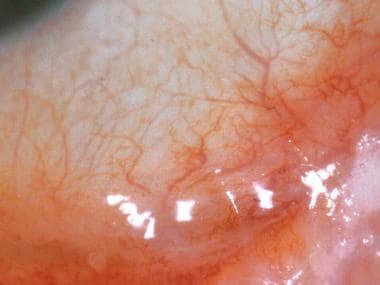
Heather is a 52-year-old executive with a six-month history of pain when eating, which has become much worse over the past two weeks.
She is otherwise well, a non-smoker who drinks alcohol socially, with no past medical history of note.
She self-initiated a regular OTC ocular lubricant in recent months for dry eye symptoms she attributes to the air conditioning at work.
She also suspects the air conditioning is the cause of a couple of instances of nosebleed with strenuous blowing.
She denies any rash or joint symptoms, and there are no allergic or atopic features.
Recent fasting blood tests for a corporate health checkup were normal.
On examination, vital signs are normal, oral findings are pictured and ocular examination reveals very mild conjunctival injection. Examination is otherwise normal.
What is the most likely diagnosis?
Correct!
Mucous membrane pemphigoid (also termed cicatricial pemphigoid) is an autoimmune blistering condition, characterised by chronic, subepithelial blisters primarily affecting mucosal surfaces.
The mucosal involvement characterises the condition, though cutaneous lesions may also occur.
It typically presents with relapsing and remitting mucosal inflammation and erosions. Intact vesicles or bullae are rarely seen on mucosa.
While painful, these lesions are typically less intensely uncomfortable than lesions associated with pemphigus.
The oral cavity is most commonly affected, followed by the ocular conjunctiva, skin, pharynx, external genitalia and nasal mucosa.
Laryngeal, anal and oesophageal involvement is occasionally reported.
The pathogenesis most likely involves autoantibody-mediated damage to the epithelial basement membrane zone, resulting in separation of the epidermis from the dermis in skin, and epithelium from subepithelial tissue in mucous membranes.
People aged over 60 are predominantly affected, with occasional cases reported in children and younger adults. Women are up to twice as likely to be affected as men.
Disease progression may result in malnutrition due to inability to tolerate oral intake, ocular scarring with visual disturbance and genitourinary distortion, depending on the sites on involvement.
The diagnosis is usually clear from the clinical findings, but is confirmed with perilesional biopsy for histopathology and direct immunofluorescence and serum tests for anti-basement membrane zone antibodies on indirect immunofluorescence assay and enzyme-linked immunosorbent assay.
Treatment aims to halt recurrent ulceration, promote healing and prevent scarring. Multidisciplinary management may be required, depending on the distribution of disease.
Mild disease limited to the oral mucosa may be managed with topical or intralesional steroids. More severe or resistant disease, or involvement of sites associated with higher risk of serious morbidity (ocular, genital, respiratory tract or oesophageal), warrant systemic therapy with corticosteroids, immunosuppressants or biologic therapies.
In cases of ocular involvement with adhesions, surgical release may be of benefit. Similarly, vulval, vaginal or anal adhesions may warrant surgical division.
Female genital disease may also benefit from topical oestrogen and vaginal dilators.
